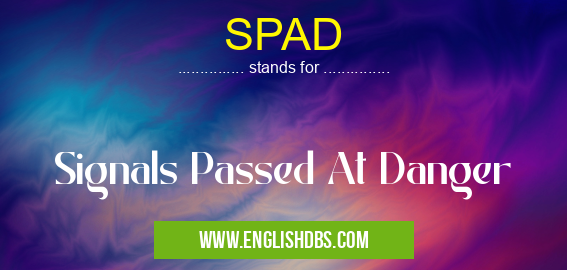What does SPAD mean in TRANSPORTATION
SPAD stands for Signals Passed At Danger which is common terminology used in the government sector, particularly related to railway safety. SPADs refer to a safety breach when a train fails to stop at a red signal or overshoots another signal. Such events can have disastrous consequences if they are not taken seriously and managed appropriately. It is important that railway operators, employees, and governments take all necessary steps to reduce the number of SPAD incidents as much as possible. To understand the risk posed by SPADs, it is useful to understand what they are and why they occur.

SPAD meaning in Transportation in Governmental
SPAD mostly used in an acronym Transportation in Category Governmental that means Signals Passed At Danger
Shorthand: SPAD,
Full Form: Signals Passed At Danger
For more information of "Signals Passed At Danger", see the section below.
Definition
SPADs stand for Signals Passed At Danger which occurs when a train has failed to stop at a red signal or have overshot another signal due to various reasons. By definition, this means that the driver either failed to observe the danger ahead or was unaware of it and thus did not act on it in time. The most serious form of SPADs occur when a collision with another moving object takes place due to the train failing to stop or slow down sufficiently in time (e.g., colliding with other trains).
Causes of SPAD
SPADs can be caused by many different factors including human error, mechanical failure, faulty track signaling equipment, inadequate training of staff members involved with operating signals/instructing locomotives, etc. Additionally, environmental factors such as bad visibility due to rain or snowfall can also contribute towards accidents resulting from Signals Passed At Danger (SPAD). Regardless of what causes them, organizations/governments must do their utmost best to ensure that these danger zones are avoided and proper mitigation strategies put into place where necessary.
How Governments Handle SPAD Incidents
Governments around the world take measures within their respective countries' rail networks so as to prevent such occurrences from taking place in the first place or minimize damages should any incident does happen. These measures include issuing specific regulations on how engineers should proceed when approaching signals as well as enhanced punishments for those who do not comply accordingly with said regulations (e.g., loss of license). Other additional measures involve education campaigns aimed at both railway staff and passengers so as to raise awareness about such dangers and how they can be prevented.
Essential Questions and Answers on Signals Passed At Danger in "GOVERNMENTAL»TRANSPORTATION"
What is a SPAD?
SPAD stands for 'Signals Passed At Danger', and refers to the situation when a train passes through a railway signal at danger. This means that the signal has been set to stop but is ignored, which can easily lead to accidents or incidents on the track.
Are there consequences to SPADs?
Yes, SPADs often result in delays and disruption for passengers, as well as potential disciplinary action taken against the driver for failing to stop at a red signal.
How can I avoid being in a SPAD situation?
The best way to avoid a SPAD is by always following railway signals - if you are approaching a red light, then be prepared to stop. If you are unsure of what action to take, it is better to err on the side of caution and come to a complete halt until further advice is given by signallers.
What happens if two trains enter a single-track section at once?
This is known as an 'entry conflict' and can potentially cause serious risk of harm on the track if not handled properly. Both drivers should immediately assess their train's position and agree with each other on which direction will be taken. The driver with the least amount of speed should give way and proceed only when it is safe to do so.
Is it possible for trains running in opposite directions to pass each other on the same track?
It is sometimes necessary for trains travelling in opposite directions to pass each other on the same single-track section, although this must be done in accordance with appropriate safety procedures such as setting appropriate speed limits and keeping lookout for other approaching trains without passing through any signals at danger (SPADs).
How does automated technology help reduce SPAD risks?
Automated technology helps rail operators more effectively monitor their rolling stock, detect potential conflicts between different movements, and take evasive action if necessary. By incorporating this technology into their operations, rail operators can increase their chances of avoiding incidents where signals have been passed at danger (SPADs).
Can I report any suspected instances of SPads seen while travelling by train?
Yes absolutely! If you witness or suspect any incidents involving panic braking or struggling drivers passing red signals then please notify Network Rail immediately by using their dedicated helpline number 0800 40 50 40 or through email using ‘[email protected]’.
Final Words:
Overall, SPAD stands for Signals Passed At Danger which refers to cases where trains fail stop at red-light signals or overshoot other signals due frequent errors/hazards such as human mistakes or poor visibility conditions etc.. As these instances may end up causing irreparable harm if overlooked; governments have implemented several preventive mechanisms ranging from tighter regulations governing how loco-operators approach signals up-front,right through more active education campaigns geared towards general public awareness regarding potential risks associated with SPADS
